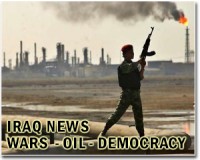 |
Washington (AFP) Sept 18, 2010 BP prepared Saturday to conclude a months-long effort to end the worst maritime oil spill in US history with the cementing of its ruptured Gulf of Mexico well. A relief well successfully intersected a shaft at the bottom of the Macondo well some 2.5 miles (four kilometers) below the sea floor on Thursday, allowing the final injection procedure to go forward. The delicate operation is supposed to permanently plug the well, bringing to a close a disaster that began nearly five months ago when an explosion ripped through the BP-leased Deepwater Horizon drilling rig, killing 11 workers. The leak that followed fouled hundreds of miles of US shores, ruined local livelihoods and wiped nearly 70 billion dollars off BP's market value. The British energy giant said it pumped cement into the busted well for seven hours on Friday. Workers were waiting for the cement to set before "standard plugging and abandonment procedures for the relief well" will go ahead so it can be finally, completely sealed. "The DDII currently is on standby and awaiting conclusion of DDIII cementing operations," BP spokesman Daren Beaudo told AFP, referring to the firm's Development Driller II and III rigs. "The cement will be allowed to set and later tested in accordance with the approved operating plan." The company said tests indicated no hydrocarbons or cement were present where the relief well -- one of two that have been drilling through bedrock since May -- finally intercepted the BP shaft. "It is expected that the MC252 well will be completely sealed on Saturday," BP said. No oil has gushed into the Gulf since July, when heavy drilling mud and cement were successfully rammed down the well from above and a cap was placed on the wellhead. But Coast Guard Rear Admiral Paul Zukunft, the on scene commander, said that while it was good news the well was finally dead, the clean-up operation "lives on." "We still have over 600 miles of shoreline from Florida to Louisiana that have been impacted and, in fact, today I have over 25,000 people out there doing very intense and high heat conditions clean up along the 600 miles," he told CNN. "Another concern has been, you know, where did the rest of the oil go?" He said 11 research vessels continued to water and sediment samples to try to answer that question. An estimated 4.9 million barrels (206 million gallons) of oil gushed out of the well off the coast of Louisiana after it ruptured following an April 20 explosion aboard the Deepwater Horizon offshore oil platform. It took 87 days to stem the flow of oil into the Gulf that sullied environmentally sensitive wetlands and shores, killed wildlife and devastated the region's multi-billion-dollar commercial and recreational fishing industry. With BP finally able to declare the well dead, the company can now focus its efforts on restoring a battered US Gulf Coast, where tourism took a big hit. Most of the massive slick has been dispersed, dissolved, burned off or skimmed off the surface, but some scientists warn the full impact may not be known for decades. BP has already spent eight billion dollars trying to contain the disaster and has forecast it will eventually cost the energy giant more than 32.2 billion dollars. On Wednesday, BP's outgoing chief Tony Hayward, who ignited American anger over his handling of the disaster, defended the firm's safety procedures to British lawmakers who grilled him over the spill and the company's response. Hayward -- whose resignation after a string of PR gaffes takes effect on October 1 -- said the spill was "devastating" to him personally but denied that cost-cutting had trumped security concerns in the run-up to the accident. He reiterated claims in BP's own report into the disaster that contractors were partly to blame. Meanwhile, US federal prosecutors are considering filing a civil complaint against BP under the Clean Water Act to claim 1,100 dollars for each barrel of oil spilled in the Gulf of Mexico.
Share This Article With Planet Earth
Related Links Powering The World in the 21st Century at Energy-Daily.com
 Iraq boosts oil plan but faces problems
Iraq boosts oil plan but faces problemsBaghdad (UPI) Sep 17, 2010 Iraq plans to upgrade its oil pipeline network to boost exports through neighboring Turkey and Syria as Baghdad struggles to develop its vast but under-exploited energy resources, the key to its reconstruction. The country faces serious obstacles - sectarian violence, political instability and deep-rooted corruption - that are likely to get worse in the years to come as the United Sta ... read more |
|
| The content herein, unless otherwise known to be public domain, are Copyright 1995-2010 - SpaceDaily. AFP and UPI Wire Stories are copyright Agence France-Presse and United Press International. ESA Portal Reports are copyright European Space Agency. All NASA sourced material is public domain. Additional copyrights may apply in whole or part to other bona fide parties. Advertising does not imply endorsement,agreement or approval of any opinions, statements or information provided by SpaceDaily on any Web page published or hosted by SpaceDaily. Privacy Statement |